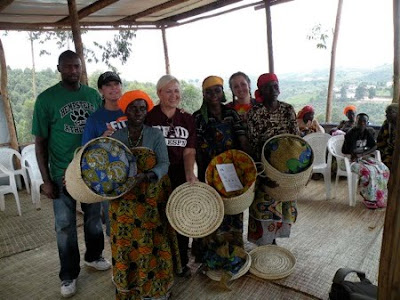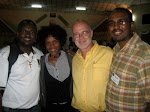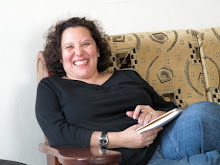
I have been fixated on fireless cookers ever since I learned about them from a friend in Mombasa this past May. I spoke about them so much that Claude threatened to start calling me Kelley 'fireless cooker' Johnson! The concept is simple: an insulted basket that allows the residual heat of the cooking vessel to complete the cooking off the fire and in the basket.
1. A woman can cook beans on the open fire for about 45 minutes, then put the pot into a fireless cooker and let it sit, unattended, for another 3 or 4 hours. The heat present in the pot, insulted in the basket, will finish the cooking process. So instead of the women sitting over the pot of beans on the fire for 4 or 5 hours, minding the fire and trying to keep the children out of the flames... she can reduce her active cooking time to 45 minutes and free the other hours for herself. She can use those additional hours to work on other things, to mind the children, or whatever else needs her attention that day. It frees her time.
2. But there is another huge advantage to fireless cookers in a rural setting - it reduces the amount of firewood or charcoal used in daily cooking. This means that women will spend less time foraging for firewood. It means they will cut down fewer trees to make charcoal. They will spend less money on fuel for the fire. It saves household time, money and energy.
3. In addition, the use of a fireless cooker means that people will cut down fewer trees for charcoal production or firewood, thus preserving their natural habitat. The land can stay in tact when fewer trees are used as fuel. So this fireless cooker is also a tool to help steward the environment where the families live. It preserves the land.
So I have been fixated on this idea, and convinced it would help our families in Matara. Claude agreed to let me try some prototypes this summer to see if there would be any traction with the concept here. So when our friends from Texas came to town, it was a perfect opportunity to go to Matara and make our first batch of fireless cookers with inexpensive and locally available materials.
We went with the basics - baskets, fabric, raw cotton, string, heavy needles and the instructions. I confess, I did get colorful fabric. It is the most inexpensive variety of the kind, but I just think that everyone appreciates the simple aesthetics of color and patterns in their kitchen! So the Batwa ladies and our Texas friends sat together and began to construct fireless cookers. They were lovely...
By the time we were nearing the end of the process, a crowd had gathered around us. The other women and all the men from the village wondered what were were making! I explained, with the help of a translator, that these baskets could keep food warm for a very long time off the fire. (I was told you begin here... then progress to the 'cooking with residual heat' in the next phase of instruction.) Right away a man blurted out a question, 'Does this mean the food will be warm when I come in from the field?' Yes! All the men cheered together! Already the idea was exciting to the men who wanted hot food on the table no matter what time they got home. (For the women, this means they can keep dinner warm in the basket, and not have to start yet another fire to reheat the food when he returns...)
But there was a slight problem... we discovered that all their pots were larger than the baskets and none of the pots had lids. So we had to go back to the city, get smaller pots with lids, and get them to Matara soon. Poor Claude got no rest until the pots were delivered to Matara!
Just this week the pots arrived and the women started testing the fireless cookers right away. When Claude was there yesterday one lady showed him her basket - with a pot inside. She cooked sweet potatoes the day before and they were still warm the next afternoon! Even with the cold night air in Matara, the insulated basket kept the sweet potatoes warm! It works!!! As you can imagine, all the women want their own fireless cooker now.
I don't get to do much in Matara, really. Claude overseas the community development work with the families day in and day out with his team (an agricultural engineer, social worker, occasional construction supervisor). I am the story-teller. But this was one idea I was so sure could help the women of Matara, could help the households and preserve the natural resources. So to see it come to life, with the help of my friends, makes me feel like I have contributed something tangible to the well-being of our friends in Matara. It is small, but it makes me smile to think that even I can offer something.

fabric, bags of raw cotton and some scissors to begin...

lining the basket with cotton, tufting it into place...







